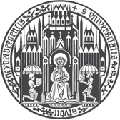ReisensbuRG Workshop
Reisensburg, June 8-10, 2009
Titles and Abstracts
Herbert Schoeller
Real-time RG in frequency space: A perturbative nonequilibrium renormalization group method for dissipative quantum mechanics
A tutorial introduction is presented to the formalism of a perturbative RG method for nonequilibrium problems in dissipative quantum mechanics, i.e. for problems of a small quantum system coupled via particle or energy exchange to several noninteracting reservoirs. Based on a convenient quantum-field theoretical diagrammatic expansion in Liouville space, it is shown how the full dynamics of the reduced density matrix can be captured microscopically, including the renormalization of the vertex, the relaxation and dephasing rates, and of the energy excitations. Furthermore, it is shown how observables ,like e.g. the current, and correlation functions can be calculated. In the weak-coupling regime and for a fermionic model with spin/orbital fluctuations, it is shown how the RG equations can be solved analytically in a systematic way. Results are shown for the nonequilibrium anisotropic Kondo model in a finite magnetic field.
slides as pdf file
Lorenz Bartosch
BEC--BCS crossover
We use the functional renormalization group (FRG) approach with partial bosonization in the particle-particle channel to obtain a quantitatively accurate description of the BCS-BEC crossover of superfluid fermions in three dimensions. Our approach is based on a new truncation of the vertex expansion where the FRG flow of bosonic two-point functions is closed by means of Dyson-Schwinger equations and the superfluid order parameter is related to the single particle gap via a Ward identity. We explicitly calculate the chemical potential, the singleparticle gap, the superfluid order parameter, and the velocity of the Bogoliubov-Anderson mode for the whole crossover regime including the unitary point and compare our results with those of other authors.
Jens Braun
Functional Renormalization Group and Density Functional Theory
Studying ground-state properties of trapped strongly-interacting Fermi gases is currently a very active frontier, both experimentally and theoretically. We propose a method for calculations of ground-state properties in the framework of density functional theory. The presented approach starts from non-interacting fermions in a background potential (a simple approximation for the mean field). The microscopic interactions are then gradually turned on in the RG flow, while the background potential is removed.
Tilman Enss
Superfluidity in ultracold Bose-Fermi mixtures
Stefan Flörchinger
News from bosonization
see arXiv:0905.0915
Simon Friederich
Emergence of d-wave oder in the two-dimensional Hubbard model with partial bosonization
The emergence of local d-wave order in the two-dimensional Hubbard model due to antiferromagnetic spin fluctuations is reconsidered in the framework of the functional renormalization group with partial bosonization.
Christoph Husemann
Singular Legendre Transforms in RG Flows
Andreas Komnik
TBA
Pawel Jakubczyk
Can order parameter fluctuations induce quantum critical points?
Mikhail Pletyukhov
The functional RG approach to the interacting resonant level model
(status report)
Dirk Schuricht
Dynamical spin-spin correlation functions in the Kondo model out of equilibrium
We calculate the dynamical spin-spin correlation functions of a Kondo dot coupled to two noninteracting leads held at different chemical potentials. To this end we generalize a recently developed real-time renormalization group method in frequency space (RTRG-FS). The resulting two-loop RG equations are analytically solved in the weak-coupling regime. This implies that the method can be applied provided either the voltage through the dot or the external magnetic field are sufficiently large compared to the Kondo temperature T_K where the system enters the strong-coupling regime. The correlation functions in real-frequency space can be calculated in Matsubara space without the need of any analytical continuation. We obtain analytic results for the line-shape, the small- and largefrequency limits and several other features. Furthermore, we present results on the time evolution of the magnetization after switching on the voltage.





